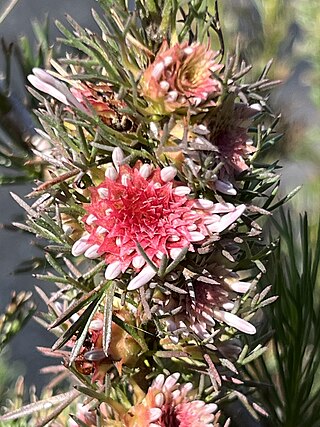
Isopogon dawsonii, commonly known as the Nepean conebush, is a shrub of the family Proteaceae and is endemic eastern to New South Wales. It has pinnate leaves with narrow segments and spherical heads of creamy yellow to greyish white flowers.

Isopogon dubius, commonly known as pincushion coneflower, is a species of plant in the family Proteaceae and is endemic to the south-west of Western Australia. It is a shrub with sharply-pointed, deeply lobed or pinnate leaves and more or less spherical heads of pink to reddish pink flowers.

Isopogon adenanthoides, commonly known as spider coneflower, is species of flowering plant in the family Proteaceae and is endemic to the southwest of Western Australia. It is an erect shrub with sharply-pointed, trifid leaves and spherical heads of pink flowers.
Persoonia rufiflora is a species of flowering plant in the family Proteaceae and is endemic to the south-west of Western Australia. It is an erect, sometimes spreading shrub with hairy young branchlets, lance-shaped to linear leaves, and hairy, greenish yellow flowers arranged singly or in pairs.

Isopogon asper is a species of plant in the family Proteaceae and is endemic to the south-west of Western Australia. It is a low shrub with crowded pinnate leaves and flattened spherical heads of glabrous pink flowers.

Isopogon divergens, commonly known as spreading coneflower, is a species of plant in the family Proteaceae and is endemic to the south-west of Western Australia. It is a shrub with pinnate leaves and more or less spherical heads of glabrous pink flowers followed by an oval to cylindrical fruiting cone.

Isopogon teretifolius, commonly known as nodding coneflower, is a species of flowering plant in the family Proteaceae and is endemic to the southwest of Western Australia. It is an erect shrub with cylindrical, sometimes branched leaves, and flattened-spherical heads of hairy pinkish flowers.

Petrophile axillaris is a species of flowering plant in the family Proteaceae and is endemic to the south-west of Western Australia. It is a shrub with pinnately-divided, sharply-pointed leaves, and spherical heads of hairy pink or grey flowers.

Petrophile biternata is a species of flowering plant in the family Proteaceae and is endemic to the south-west of Western Australia. It is a shrub with biternate or pinnate, sharply-pointed leaves, and oval or spherical heads of glabrous, sticky, yellow flowers.
Petrophile chrysantha is a species of flowering plant in the family Proteaceae and is endemic to the south-west of Western Australia. It is a small shrub with crowded, sharply-pointed, pinnately-divided leaves, and oval heads of hairy, cream-coloured to dark yellow flowers.
Petrophile circinata is a species of flowering plant in the family Proteaceae and is endemic to the south-west of Western Australia. It is a low, spreading shrub with pinnately-divided, sharply-pointed leaves, and more or less spherical heads of hairy, white, yellow or cream-coloured flowers.

Petrophile conifera is a species of flowering plant in the family Proteaceae and is endemic to the south-west of Western Australia. It is a bushy, much-branched shrub with pinnate, sharply-pointed leaves, and oval heads of hairy, cream-coloured to yellowish white flowers.

Petrophile drummondii is a species of flowering plant in the family Proteaceae and is endemic to southwestern Western Australia. It is a shrub with rigid, pinnate leaves with needle-shaped, sharply-pointed pinnae, and spherical heads of hairy, fragrant, yellow flowers.

Petrophile misturata is a species of flowering plant in the family Proteaceae and is endemic to southwestern Western Australia. It is a shrub with simple and pinnate, needle-shaped leaves and spherical heads of hairy, dull yellow flowers.

Petrophile plumosa is a species of flowering plant in the family Proteaceae and is endemic to southwestern Western Australia. It is a shrub with rigid, sharply-pointed, sometimes lobed leaves, and more or less spherical heads of hairy, pale yellow flowers.

Isopogon linearis is a small shrub in the family Proteaceae that is endemic to the southwest of Western Australia.

Isopogon scabriusculus is a species of flowering plant in the family Proteaceae and is endemic to southwestern Western Australia. It is a shrub with cylindrical, or narrow flat, sometimes forked leaves, and spherical to oval heads of pink or red flowers.

Isopogon tridens, commonly known as the three-toothed coneflower, is a species of flowering plant in the family Proteaceae and is endemic to the southwest of Western Australia. It is a shrub with wedge-shaped leaves with two or three sharply-pointed teeth, and flattened-spherical heads of glabrous creamy white, sometimes purple flowers.

Isopogon villosus is a species of flowering plant in the family Proteaceae and is endemic to southwestern Western Australia. It is a tufted shrub with cylindrical leaves with twenty-five to thirty-two widely diverging lobes, and oval heads of cream-coloured to yellow flowers.

Isopogon heterophyllus is a plant in the family Proteaceae and is endemic to the southwest of Western Australia. It is a shrub with simple or pinnate, cylindrical leaves and hairy, usually pink flowers.

















